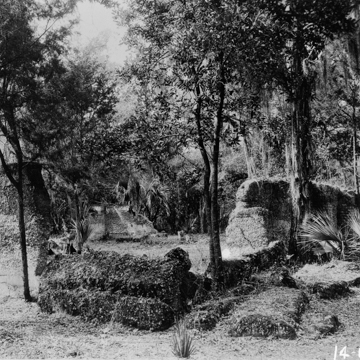You are here
Wormsloe Historic Site
Among the first colonists to arrive in Georgia with James Oglethorpe in 1733 was Noble Jones (1702–1775), whose fortified house at Wormslow (later Wormsloe) survives in ruin at the end of a spectacular avenue of live oaks and Spanish moss. The name likely derives from the Jones’s ancestral home along the Welsh border at Wormslow Hundred, Herefordshire. Jones’s house was built using tabby, a colonial building material that combined local oyster shells, lime (from burnt oyster shells), water, sand, and ash in a crude concrete-like aggregate. Tabby survives in Georgia in other rare examples such as the Major William Horton House, built around 1740. At Wormsloe, the later family country residence called Wormsloe House, a timber dwelling with sections dating to around 1830, was sited on the original acreage and remains the ancestral home of Noble Jones’s descendants.
Jones was a physician and part-time carpenter who had arrived in Georgia with his wife and two children. Like other colonists who accompanied Oglethorpe from England, Jones was granted a farm outside the town in addition to a town lot in Savannah (he would eventually amass five town lots). His 1736 lease application for two square kilometers (500 acres) of farm land on Isle of Hope was finally granted in 1745, three years after the Battle of Bloody Marsh, although Wormsloe’s fortified house was likely built during the interval.
He built his fortified tabby house on the southeastern tip of the island overlooking the Skidaway Narrows. The residence consisted of eight-foot-high walls with bastions at each of the four corners, and contained five rooms within a one-and-a-half-story structure. The site was a strategic section of the Skidaway River about nine miles from Savannah’s riverfront, and roughly the same distance from the Atlantic Ocean. Jones served the new colony as a military officer charged with defending the Georgia coast from the Spanish, so Jones used Wormsloe as a guard post, commanding a garrison of twelve marines from his tabby fortified house. Thus, Wormsloe began as part of a network of coastal defense established by Georgia’s founder to protect Savannah. Fort Frederica was General Oglethorpe’s nearby military headquarters.
Conflict did occur between 1739 and 1748, initially over issues of the British asiento (contract) rights to conduct unlimited slave trade in Spanish America, and then over the War of Austrian Secession that pitted Britain (allied with Austria and the Netherlands) against France and Spain (allied with Prussia). In the colonies, Noble Jones was part of a raiding party against the Spanish in northern Florida and later helped defend Fort Frederica against the Spanish. After Spanish threats in Georgia came to an end with the Treaty of Aix-la-Chapelle, Jones returned to farming and Wormsloe became an active plantation where Jones raised corn, rice, fruits, vegetables, and possibly indigo. Mulberry trees suggest an unsuccessful effort to produce silk. The plantation was never profitable, but Jones’s real estate ventures increased to some 5,500 acres during his lifetime. Jones served the colony in many capacities: as doctor, constable, Indian agent, Royal Councilor, and surveyor (in the latter role laying out the towns of Augusta and New Ebenezer). At the time of his death in 1775, the eve of the American Revolution, Jones, who remained loyal to King George, found himself in conflict with his son, Noble Wimberly Jones, a supporter of the Patriot cause. Nonetheless, Jones stipulated that after the death of his daughter, Wormsloe would pass to Noble Wimberly and thence to Noble Wimberly’s heirs.
Wormsloe House, the family’s country residence built around 1830 with later additions, is extant but private. Wimberly Jones De Renne (1853–1916) planted over 400 oak trees that form the oak allée today. De Renne was added to the family name by George Frederick Tilghman Jones (1827–1880), who changed his name to George Wimberley Jones De Renne and also changed the spelling of Wormslow to Wormsloe, planted the first oak allée, and expanded Wormsloe House. In 1927 the estate grounds were opened to visitors as Wormsloe Gardens, a tourist attraction that was said to rival South Carolina's Magnolia Gardens. But it is the tabby house from pre-revolutionary years that remains the focus of the state historic site today. Much of the original dense, oak-pine maritime forest surrounding the house predated European settlement of the Isle of Hope. Most of the old-growth pines, however, were lost during pine beetle infestations in the 1970s, the decade in which the site passed to the state. The State of Georgia acquired the bulk of the Wormsloe Plantation in 1973 and opened it to the public in 1979. Descendants of Noble Jones, however, still live in Wormsloe House, just beyond the oaks.
References
E. Merton Coulter. Wormsloe: Two Centuries of a Georgia Family. Athens, Georgia: University of Georgia Press, 1955.
Writing Credits
If SAH Archipedia has been useful to you, please consider supporting it.
SAH Archipedia tells the story of the United States through its buildings, landscapes, and cities. This freely available resource empowers the public with authoritative knowledge that deepens their understanding and appreciation of the built environment. But the Society of Architectural Historians, which created SAH Archipedia with University of Virginia Press, needs your support to maintain the high-caliber research, writing, photography, cartography, editing, design, and programming that make SAH Archipedia a trusted online resource available to all who value the history of place, heritage tourism, and learning.

